Revealing the Spatial-Temporal Evolution and Obstacles of Ecological Security in the Xiamen-Zhangzhou-Quanzhou Region, China
Abstract
1. Introduction
2. Materials and Methods
2.1. Study Area
2.2. Data Sources
2.3. Research Methods
2.3.1. The DPSIR Model
2.3.2. Index Selection
2.3.3. ESL Evaluation Methods
- Original matrix normalization processing
- Calculation of the evaluation index weights
- Combined weight
- Comprehensive evaluation
2.3.4. Classification of the ESI
2.3.5. Exploratory Spatial Data Analysis
- Global spatial autocorrelation
- Local spatial autocorrelation
2.3.6. Obstacle Degree Analysis
3. Results
3.1. Analysis of ESI Spatial and Temporal Characteristics
3.1.1. ESI Temporal Characteristics
3.1.2. ESI Spatial Evolution Characteristics
3.2. ESI Spatial Correlation in the XZQR
3.2.1. Changes in Spatial Interrelationships
3.2.2. Characteristics of Spatial Interrelationships
3.3. Obstacle Degree Analysis
3.3.1. Obstacle Degree Analysis of the Criterion Layer
3.3.2. Obstacle Degree Analysis of the Index Layer
4. Discussion
4.1. Main Findings
4.2. Implications and Limitations
5. Conclusions
Author Contributions
Funding
Institutional Review Board Statement
Informed Consent Statement
Data Availability Statement
Acknowledgments
Conflicts of Interest
References
- Cheng, H.; Zhu, L.; Meng, J. Fuzzy evaluation of the ecological security of land resources in mainland China based on the Pressure-State-Response framework. Sci. Total Environ. 2022, 804, 150053. [Google Scholar] [CrossRef]
- Jatav, S.S.; Naik, K. Measuring the agricultural sustainability of India: An application of Pressure-State-Response (PSR) model. Reg. Sustain. 2023, 4, 218–234. [Google Scholar] [CrossRef]
- Bi, M.; Xie, G.; Yao, C. Ecological security assessment based on the renewable ecological footprint in the Guangdong -Hong Kong -Macao Greater Bay Area, China. Ecol. Indic. 2020, 116, 106432. [Google Scholar] [CrossRef]
- Gari, S.R.; Newton, A.; Icely, J.D. A review of the application and evolution of the DPSIR framework with an emphasis on coastal social-ecological systems. Ocean Coast. Manag. 2015, 103, 63–77. [Google Scholar] [CrossRef]
- Yu, Y.; Bao, Y.; Zhang, Q.; Shen, P.; Yang, H.; Xu, Z. Evaluation of marine resources environmental responsibility audit based on PSR framework. Ocean Coast. Manag. 2023, 245, 106742. [Google Scholar] [CrossRef]
- Xiao, Y.; Zhong, J.; Wang, J.; Zhang, L.; Qian, X.; Liu, W.; Huang, H. Exploring the Coupling Coordination Relationship of Urban Resilience System in Ecologically Fragile Areas: Case Study of the Loess Plateau in China. Land 2023, 12, 1997. [Google Scholar] [CrossRef]
- Salvati, L.; Carlucci, M. A composite index of sustainable development at the local scale: Italy as a case study. Ecol. Indic. 2014, 43, 162–171. [Google Scholar] [CrossRef]
- Holdgate, M.W. Our Common Future: The Report of the World Commission on Environment and Development. Environ. Conserv. 1987, 14, 282. [Google Scholar] [CrossRef]
- Xie, B.; Jones, P.; Dwivedi, R.; Bao, L.; Liang, R. Evaluation, comparison, and unique features of ecological security in southwest China: A case study of Yunnan Province. Ecol. Indic. 2023, 153, 110453. [Google Scholar] [CrossRef]
- Liu, C.; Li, W.; Xu, J.; Zhou, H.; Li, C.; Wang, W. Global trends and characteristics of ecological security research in the early 21st century: A literature review and bibliometric analysis. Ecol. Indic. 2022, 137, 108734. [Google Scholar] [CrossRef]
- Zhao, C.; Wang, C.; Yan, Y.; Shan, P.; Li, J.; Chen, J. Ecological Security Patterns Assessment of Liao River Basin. Sustainability 2018, 10, 2401. [Google Scholar] [CrossRef]
- Zhang, K.; Lin, N.; Xu, D.; Yu, D.; Zou, C. Research Advance on Ecological Security in China: Assessment Models and Management Measures. J. Ecol. Rural Environ. 2018, 34, 1057–1063. [Google Scholar]
- Qiu, M.; Yang, Z.; Zuo, Q.; Wu, Q.; Jiang, L.; Zhang, Z.; Zhang, J. Evaluation on the relevance of regional urbanization and ecological security in the nine provinces along the Yellow River, China. Ecol. Indic. 2021, 132, 108346. [Google Scholar] [CrossRef]
- von Döhren, P.; Haase, D. Ecosystem Services for Planning Post-Mining Landscapes Using the DPSIR Framework. Land 2023, 12, 1077. [Google Scholar] [CrossRef]
- Sun, Y.; Dong, Y.; Chen, X.; Song, M. Dynamic evaluation of ecological and economic security: Analysis of China. J. Clean. Prod. 2023, 387, 135922. [Google Scholar] [CrossRef]
- Xiaomin, Z.; Zhaoyou, L. Coupling Coordination between Ecological Security and Economy Development in the Fujian Triangle Urban Agglomeration. Areal Res. Dev. 2022, 41. [Google Scholar]
- Liu, L.; Li, J.; Wang, J.; Liu, F.; Cole, J.; Sha, J.; Jiao, Y.; Zhou, J. The establishment of an eco-environmental evaluation model for southwest China and eastern South Africa based on the DPSIR framework. Ecol. Indic. 2022, 145, 109687. [Google Scholar] [CrossRef]
- Du, Y.-W.; Cao, W.-M. DEPD model for evaluating marine ranching ecological security and its application in Shandong, China. Ocean Coast. Manag. 2022, 224, 106206. [Google Scholar] [CrossRef]
- Sobhani, P.; Esmaeilzadeh, H.; Wolf, I.D.; Deljouei, A.; Marcu, M.V.; Sadeghi, S.M.M. Evaluating the ecological security of ecotourism in protected area based on the DPSIR model. Ecol. Indic. 2023, 155, 110957. [Google Scholar] [CrossRef]
- Du, Y.-W.; Gao, K. Ecological security evaluation of marine ranching with AHP-entropy-based TOPSIS: A case study of Yantai, China. Mar. Policy 2020, 122, 104223. [Google Scholar] [CrossRef]
- He, N.; Zhou, Y.; Wang, L.; Li, Q.; Zuo, Q.; Liu, J.; Li, M. Spatiotemporal evaluation and analysis of cultivated land ecological security based on the DPSIR model in Enshi autonomous prefecture, China. Ecol. Indic. 2022, 145, 109619. [Google Scholar] [CrossRef]
- Wei, Q.; Halike, A.; Yao, K.; Chen, L.; Balati, M. Construction and optimization of ecological security pattern in Ebinur Lake Basin based on MSPA-MCR models. Ecol. Indic. 2022, 138, 108857. [Google Scholar] [CrossRef]
- Cao, B.; Zou, C.; Gao, J.; He, P. Review on Methodology and Application of Ecological Security Assessment. J. Ecol. Rural Environ. 2019, 35, 953–963. [Google Scholar]
- Manservisi, F.; Banzi, M.; Tonelli, T.; Veronesi, P.; Ricci, S.; Distante, D.; Faralli, S.; Bortone, G. Environmental complaint insights through text mining based on the driver, pressure, state, impact, and response (DPSIR) framework: Evidence from an Italian environmental agency. Reg. Sustain. 2023, 4, 261–281. [Google Scholar] [CrossRef]
- Ou, D.; Xia, J.; Ou, X. Regional Ecological Security Assessment and Change Trend Prediction in Peri-Urban Areas Based on GIS and RBF: A Case Study in Longquanyi District of Chengdu City. Geogr. Geo-Inf. Sci. 2017, 33, 49–58. [Google Scholar]
- Chen, H.; Xu, J.; Zhang, K.; Guo, S.; Lv, X.; Mu, X.; Yang, L.; Song, Y.; Hu, X.; Ma, Y.; et al. New insights into the DPSIR model: Revealing the dynamic feedback mechanism and efficiency of ecological civilization construction in China. J. Clean. Prod. 2022, 348, 131377. [Google Scholar] [CrossRef]
- Zhang, L.; Peng, W.; Zhang, J. Assessment of Land Ecological Security from 2000 to 2020 in the Chengdu Plain Region of China. Land 2023, 12, 1448. [Google Scholar] [CrossRef]
- Ghosh, S.; Chatterjee, N.D.; Dinda, S. Urban ecological security assessment and forecasting using integrated DEMATEL-ANP and CA-Markov models: A case study on Kolkata Metropolitan Area, India. Sustain. Cities Soc. 2021, 68, 102773. [Google Scholar] [CrossRef]
- Wang, Z.; Fu, X. Scheme simulation and predictive analysis of water environment carrying capacity in Shanxi Province based on system dynamics and DPSIR model. Ecol. Indic. 2023, 154, 110862. [Google Scholar] [CrossRef]
- Xiaobin, M.; Biao, S.; Guolin, H.; Xing, Z.; Li, L. Evaluation and spatial effects of tourism ecological security in the Yangtze River Delta. Ecol. Indic. 2021, 131, 108190. [Google Scholar] [CrossRef]
- Dai, L.; Liu, Y.; Luo, X. Integrating the MCR and DOI models to construct an ecological security network for the urban agglomeration around Poyang Lake, China. Sci. Total Environ. 2021, 754, 141868. [Google Scholar] [CrossRef] [PubMed]
- Peng, J.; Yang, Y.; Liu, Y.; Hu, Y.n.; Du, Y.; Meersmans, J.; Qiu, S. Linking ecosystem services and circuit theory to identify ecological security patterns. Sci. Total Environ. 2018, 644, 781–790. [Google Scholar] [CrossRef] [PubMed]
- Xiang, L.; Shui-ping, W.; Bing-qi, J.; Yi-jing, L. Atmospheric NH3 Emission Inventory and Its Tempo-spatial Changes in Xiamen-Zhangzhou-Quanzhou Region from 2015 to 2020. Environ. Sci. 2022, 43, 4914–4923. [Google Scholar]
- Guo, R.; Fan, J.; Liu, H. Impact of Resource-Environmental Restriction on the Layout of Metropolitan Area: A Case Study of Xiamen-Zhangzhou-Quanzhou Metropolitan Area. Econ. Geogr. 2021, 41, 10–19. [Google Scholar]
- Khemiri, K.; Jebari, S.; Mahdhi, N.; Saidi, I.; Berndtsson, R.; Bacha, S. Drivers of Long-Term Land-Use Pressure in the Merguellil Wadi, Tunisia, Using DPSIR Approach and Remote Sensing. Land 2022, 11, 138. [Google Scholar] [CrossRef]
- Ruan, W.; Li, Y.; Zhang, S.; Liu, C.-H. Evaluation and drive mechanism of tourism ecological security based on the DPSIR-DEA model. Tour. Manag. 2019, 75, 609–625. [Google Scholar] [CrossRef]
- Quevedo, J.M.D.; Lukman, K.M.; Ulumuddin, Y.I.; Uchiyama, Y.; Kohsaka, R. Applying the DPSIR framework to qualitatively assess the globally important mangrove ecosystems of Indonesia: A review towards evidence-based policymaking approaches. Mar. Policy 2023, 147, 105354. [Google Scholar] [CrossRef]
- Cai, X.; Li, Z.; Liang, Y. Tempo-spatial changes of ecological vulnerability in the arid area based on ordered weighted average model. Ecol. Indic. 2021, 133, 108398. [Google Scholar] [CrossRef]
- Gong, J.; Jin, T.; Cao, E.; Wang, S.; Yan, L. Is ecological vulnerability assessment based on the VSD model and AHP-Entropy method useful for loessial forest landscape protection and adaptative management? A case study of Ziwuling Mountain Region, China. Ecol. Indic. 2022, 143, 109379. [Google Scholar] [CrossRef]
- Yang, G.; Gui, Q.; Liu, J.; Chen, X.; Cheng, S. Spatial-temporal evolution and driving factors of ecological security in China based on DPSIR-DEA model: A case study of the Three Gorges reservoir area. Ecol. Indic. 2023, 154, 110777. [Google Scholar] [CrossRef]
- Ke, X.; Wang, X.; Guo, H.; Yang, C.; Zhou, Q.; Mougharbel, A. Urban ecological security evaluation and spatial correlation research—Based on data analysis of 16 cities in Hubei Province of China. J. Clean. Prod. 2021, 311, 127613. [Google Scholar] [CrossRef]
- Zhang, M.; Yu, L.; Zhang, H.; Jing, Z. Assessment of the ecological security of water environment in Henan based on PSR Model. Ecol. Sci. 2017, 36, 49–54. [Google Scholar]
- Yan, B.; Lv, S.; Zhao, M.; Han, G. Advances in the Research on Assessment Methods of Grassland Ecological Security. Chin. J. Grassl. 2019, 41, 164–171. [Google Scholar]
- Zheng, Y.; Yu, G.; Zhong, P.L.; Wang, Y.X. Integrated assessment of coastal ecological security based on land use change and ecosystem services in the Jiaozhou Bay, Shandong Peninsula, China. Yingyong Shengtai Xuebao 2018, 29, 4097–4105. [Google Scholar]
- Dezhi, X.; Shengze, Z.; Zhaomei, L.; Biaocai, Z.; Haibin, H. Research on Accelerating the Intercity of Xiamen-Zhangzhou-Quanzhou Golden Triangle: From the Perspective of the “14th Five Year Plan” and Medium and Long Term Planning. Urban Dev. Stud. 2021, 28. [Google Scholar]
- Tang, C.; Wu, X.; Zheng, Q.; Lyu, N. Ecological security evaluations of the tourism industry in Ecological Conservation Development Areas: A case study of Beijing’s ECDA. J. Clean. Prod. 2018, 197, 999–1010. [Google Scholar] [CrossRef]
- Carnohan, S.A.; Trier, X.; Liu, S.; Clausen, L.P.W.; Clifford-Holmes, J.K.; Hansen, S.F.; Benini, L.; McKnight, U.S. Next generation application of DPSIR for sustainable policy implementation. Curr. Res. Environ. Sustain. 2023, 5, 100201. [Google Scholar] [CrossRef]
- Ezeonu, I.C.; Ezeonu, F.C. The environment and global security. Environmentalist 2000, 20, 41–48. [Google Scholar] [CrossRef]

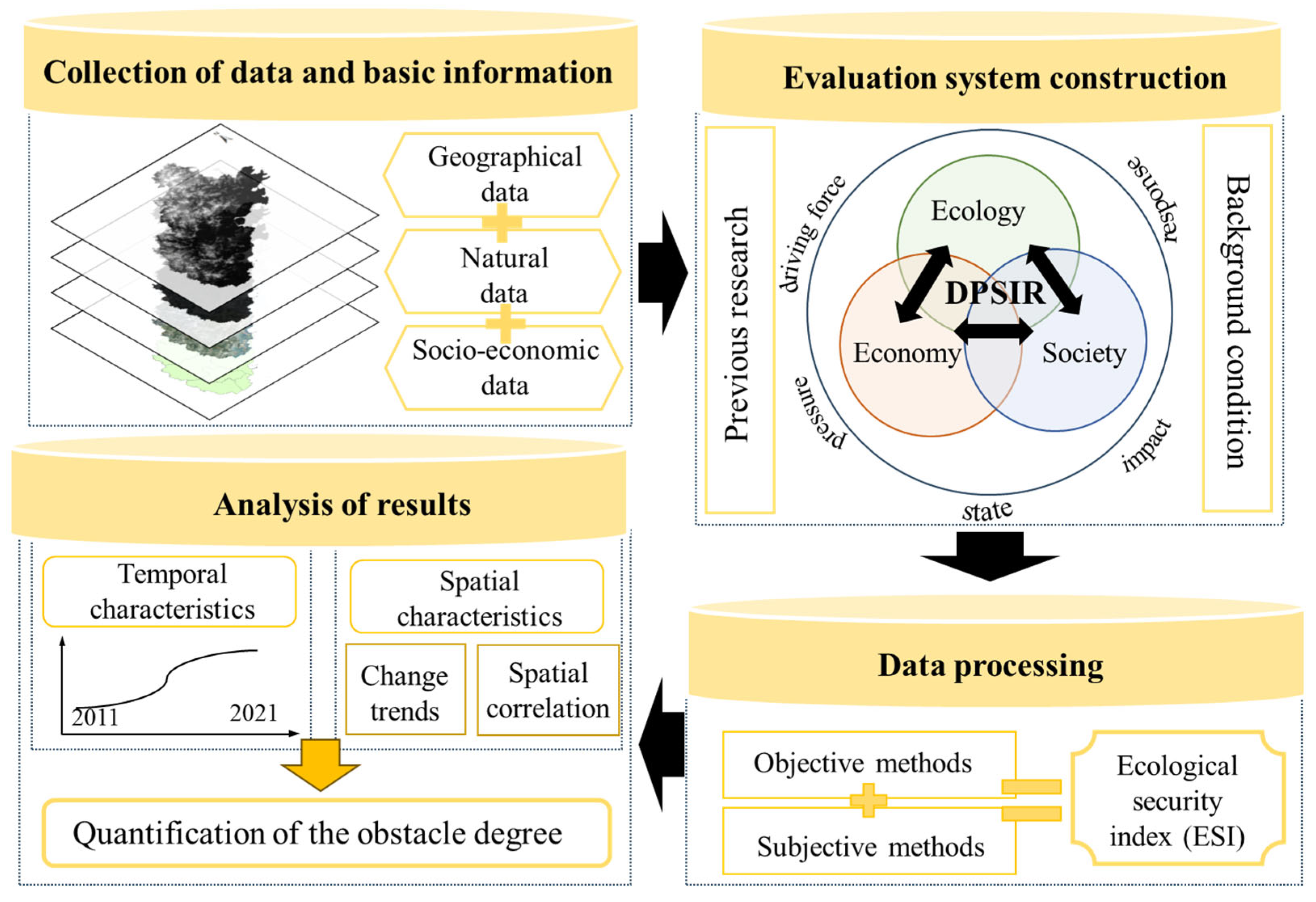


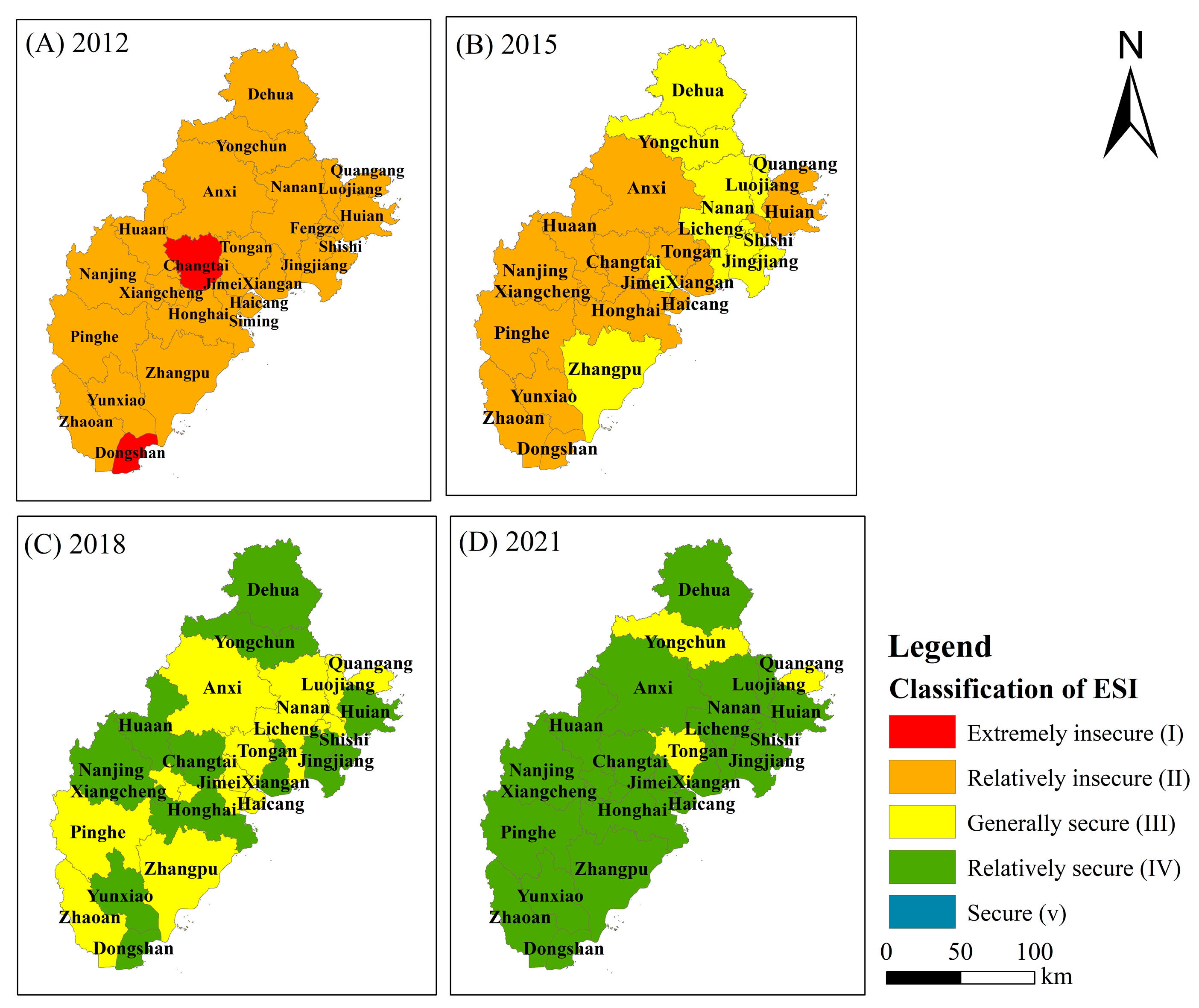
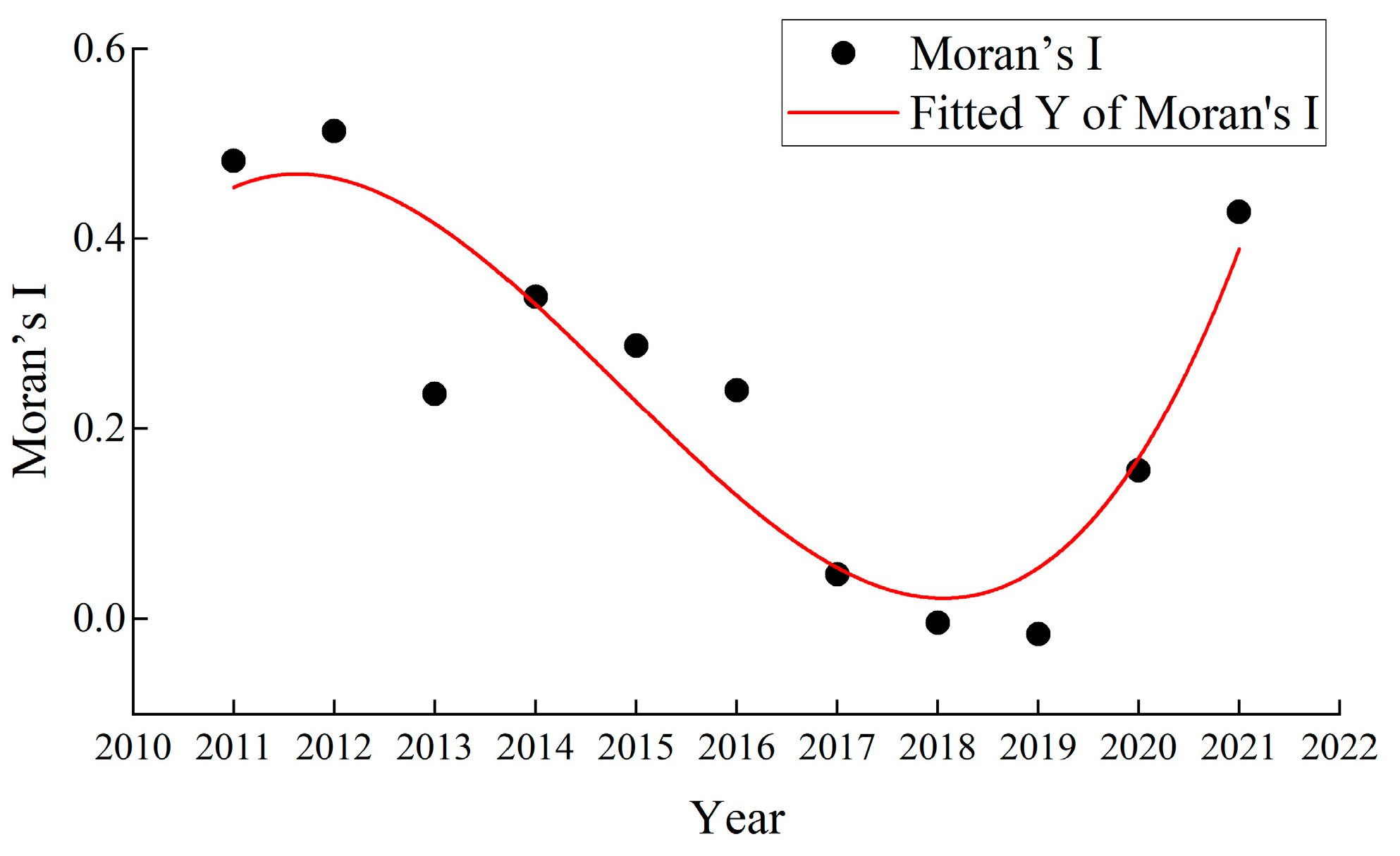
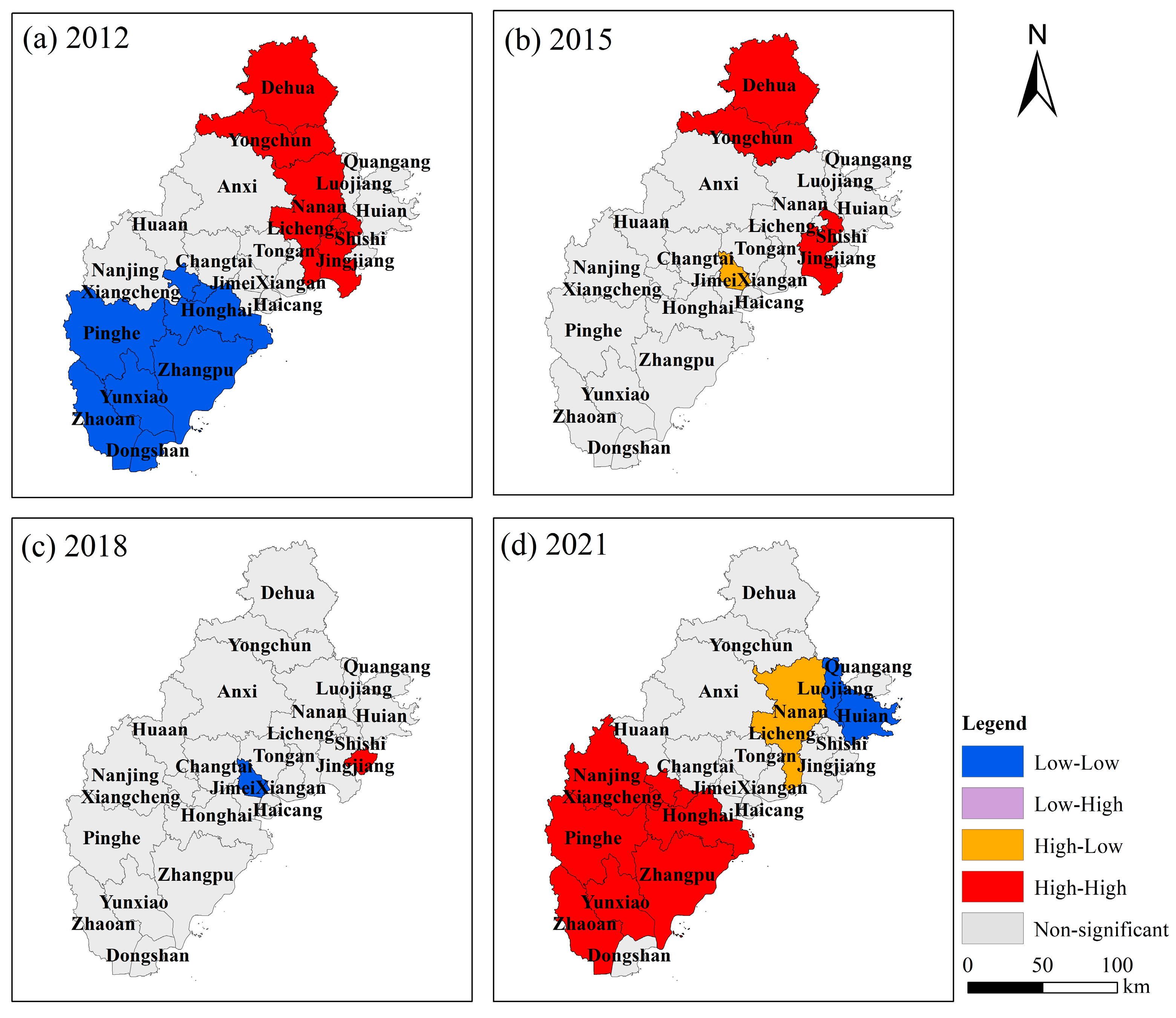

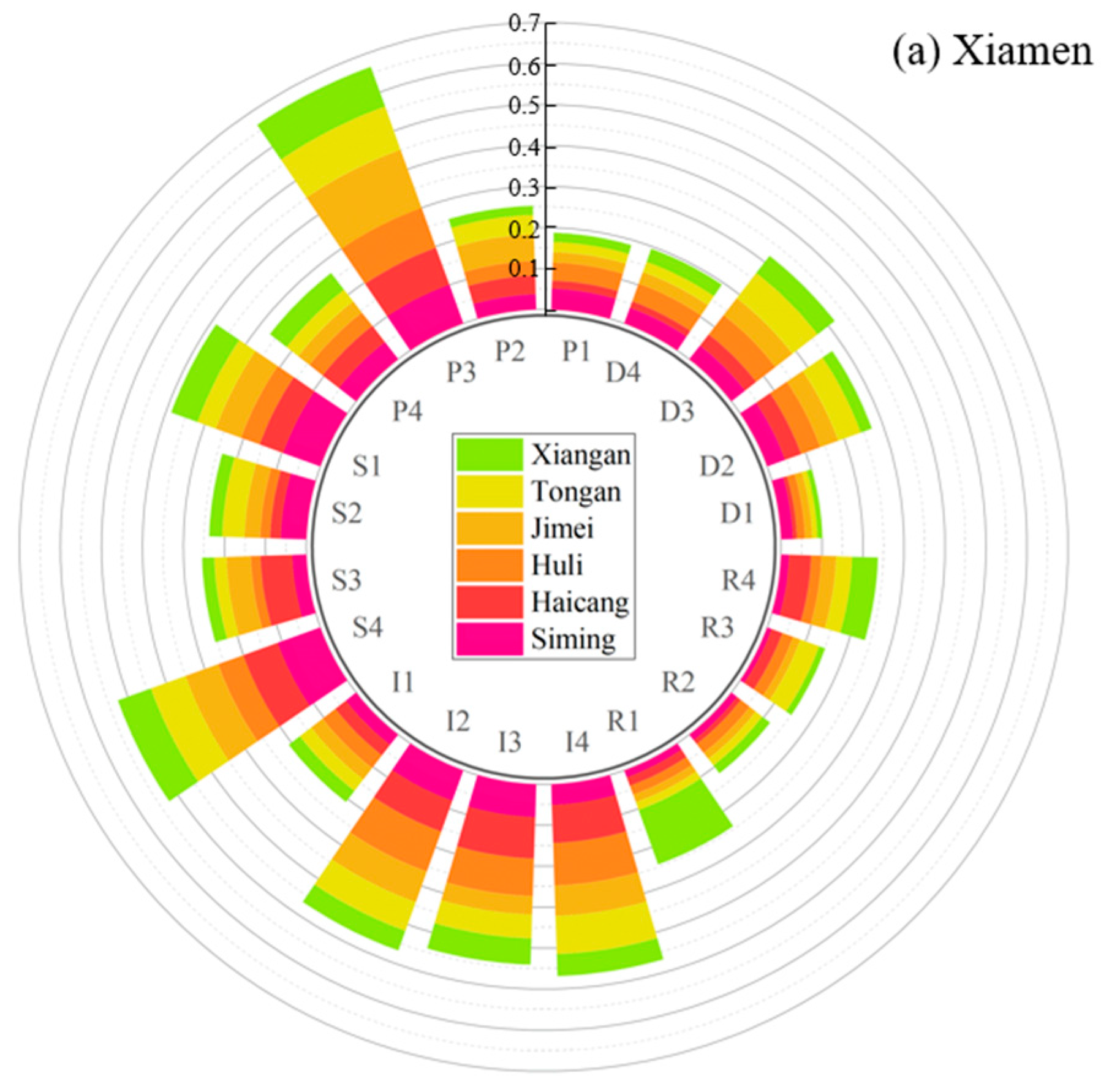
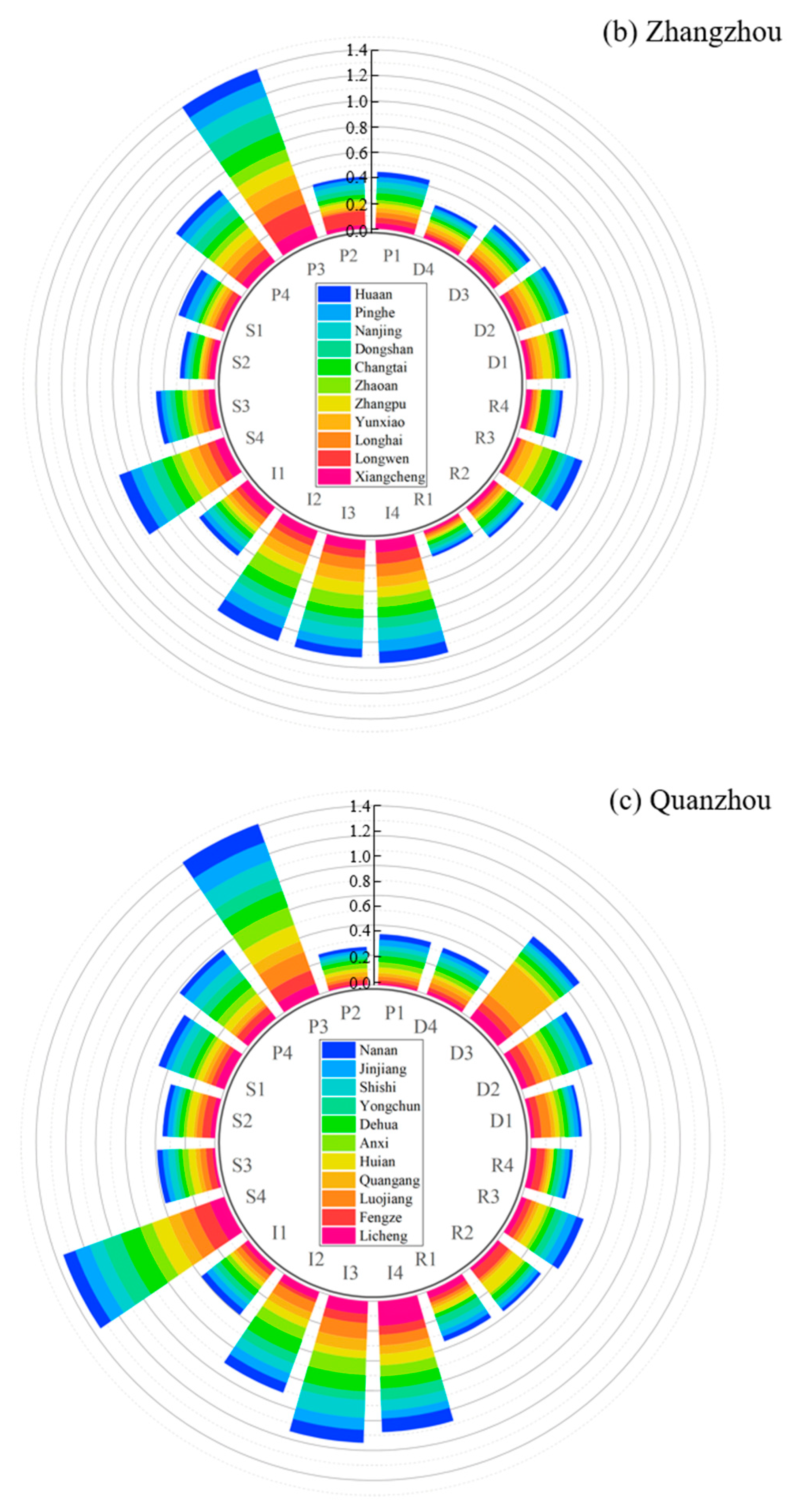
| Type | Data | Sources | Description |
|---|---|---|---|
| Geographical data | Administrative divisions | Ministry of Natural Resources of the People’s Republic of China | http://bzdt.ch.mnr.gov.cn/ (accessed on 1 December 2023) |
| Natural and environmental data | Carbon emission data | The National Oceanic and Atmospheric Administration (NOAA) | https://www.ngdc.noaa.gov/ (accessed on 1 December 2023) |
| PM2.5 data | Google Earth Engine | https://developers.google.cn/earth-engine/ (accessed on 1 December 2023) | |
| Rainfall data | |||
| Socio-economic and demographic data | The Statistical Yearbook | Statistics Bureau of Fujian, Xiamen, Zhangzhou, and Quanzhou | https://tjj.fujian.gov.cn/ (accessed on 1 December 2023); https://tjj.xm.gov.cn/ (accessed on 1 December 2023); http://tjj.quanzhou.gov.cn/ (accessed on 1 December 2023); http://tjj.zhangzhou.gov.cn/ (accessed on 1 December 2023) |
| Criterion Layer | Index Layer | Abbreviation | Weights |
|---|---|---|---|
| Driving force factors (D) | Natural population growth rate (%) | D1 | 0.0227 |
| GDP per capita (CNY) | D2 | 0.0587 | |
| Total output value of agriculture, forestry, fisheries, and animal husbandry (CNY 10,000) | D3 | 0.0515 | |
| Investment in fixed assets (CNY 10,000) | D4 | 0.0295 | |
| Pressure factors (P) | Population density (person/km2) | P1 | 0.0176 |
| Growth rate of industrial added value above designated size (%) | P2 | 0.0401 | |
| CO2 emission (10,000 tons) | P3 | 0.0856 | |
| PM2.5 emission (10,000 tons) | P4 | 0.0569 | |
| State factors (S) | Total aquatic products (tons) | S1 | 0.0647 |
| Expenditure on agriculture, forestry, and water (CNY 10,000) | S2 | 0.0175 | |
| Grain production per unit area (tons) | S3 | 0.0318 | |
| Annual precipitation (mm) | S4 | 0.0862 | |
| Impact factors (I) | Disposable income per capita (CNY) | I1 | 0.0227 |
| Green coverage rate (%) | I2 | 0.1027 | |
| GDP growth rate (%) | I3 | 0.0956 | |
| General public budget expenditure (CNY 10,000) | I4 | 0.1062 | |
| Response factors (R) | Growth rate of tertiary industry (%) | R1 | 0.0161 |
| Science and technology expenditure (CNY 10,000) | R2 | 0.0184 | |
| Sewage treatment rate (%) | R3 | 0.0518 | |
| Proportion of investment in environmental pollution control in GDP (%) | R4 | 0.0237 |
| Rank | Interval | Security Level |
|---|---|---|
| I | 0.0 ≤ ESI < 0.2 | Extremely insecure |
| II | 0.2 ≤ ESI < 0.4 | Relatively insecure |
| III | 0.4 ≤ ESI < 0.6 | Generally secure |
| IV | 0.6 ≤ ESI < 0.8 | Relatively secure |
| V | 0.8 ≤ ESI ≤ 1.0 | Secure |
| Index Layer | Sum | Average | |||
|---|---|---|---|---|---|
| Abbreviation | Xiamen | Zhangzhou | Quanzhou | ||
| Natural population growth rate (%) | D1 | 0.1013 | 0.3487 | 0.3412 | 0.0283 |
| GDP per capita (CNY) | D2 | 0.2719 | 0.4291 | 0.5065 | 0.0431 |
| Total output value of agriculture, forestry, fisheries, and animal husbandry (CNY 10,000) | D3 | 0.3198 | 0.3649 | 0.6937 | 0.0492 |
| Investment in fixed assets (CNY 10,000) | D4 | 0.1939 | 0.2741 | 0.3303 | 0.0285 |
| Population density (person/km2) | P1 | 0.1874 | 0.4459 | 0.3410 | 0.0348 |
| Growth rate of industrial added value above designated size (%) | P2 | 0.2533 | 0.4071 | 0.2548 | 0.0327 |
| CO2 emission (10,000 tons) | P3 | 0.6655 | 1.4050 | 1.2131 | 0.1173 |
| PM2.5 emission (10,000 tons) | P4 | 0.2669 | 0.7099 | 0.5816 | 0.0557 |
| Total aquatic products (tons) | S1 | 0.3871 | 0.3804 | 0.4687 | 0.0442 |
| Expenditure on agriculture, forestry, and water (CNY 10,000) | S2 | 0.2378 | 0.2742 | 0.3518 | 0.0309 |
| Grain production per unit area (tons) | S3 | 0.2549 | 0.4607 | 0.3881 | 0.0394 |
| Annual precipitation (mm) | S4 | 0.5253 | 0.8740 | 1.1486 | 0.0910 |
| Disposable income per capita (CNY) | I1 | 0.2083 | 0.4807 | 0.3966 | 0.0388 |
| Green coverage rate (%) | I2 | 0.4676 | 0.9162 | 0.7174 | 0.0750 |
| GDP growth rate (%) | I3 | 0.4403 | 0.9190 | 0.9491 | 0.0824 |
| General public budget expenditure (CNY 10,000) | I4 | 0.4681 | 0.9637 | 0.8770 | 0.0825 |
| Growth rate of tertiary industry (%) | R1 | 0.2439 | 0.2143 | 0.3517 | 0.0289 |
| Science and technology expenditure (CNY 10,000) | R2 | 0.1195 | 0.3009 | 0.3664 | 0.0281 |
| Sewage treatment rate (%) | R3 | 0.1507 | 0.5441 | 0.4416 | 0.0406 |
| Proportion of investment in environmental pollution control in GDP (%) | R4 | 0.2365 | 0.2871 | 0.2808 | 0.0287 |
Disclaimer/Publisher’s Note: The statements, opinions and data contained in all publications are solely those of the individual author(s) and contributor(s) and not of MDPI and/or the editor(s). MDPI and/or the editor(s) disclaim responsibility for any injury to people or property resulting from any ideas, methods, instructions or products referred to in the content. |
© 2024 by the authors. Licensee MDPI, Basel, Switzerland. This article is an open access article distributed under the terms and conditions of the Creative Commons Attribution (CC BY) license (https://creativecommons.org/licenses/by/4.0/).
Share and Cite
Zhang, Y.; Zhang, J.; Li, Y.; Liang, S.; Chen, W.; Dai, Y. Revealing the Spatial-Temporal Evolution and Obstacles of Ecological Security in the Xiamen-Zhangzhou-Quanzhou Region, China. Land 2024, 13, 339. https://doi.org/10.3390/land13030339
Zhang Y, Zhang J, Li Y, Liang S, Chen W, Dai Y. Revealing the Spatial-Temporal Evolution and Obstacles of Ecological Security in the Xiamen-Zhangzhou-Quanzhou Region, China. Land. 2024; 13(3):339. https://doi.org/10.3390/land13030339
Chicago/Turabian StyleZhang, Yaping, Jianjun Zhang, Yufei Li, Sen Liang, Wei Chen, and Yixin Dai. 2024. "Revealing the Spatial-Temporal Evolution and Obstacles of Ecological Security in the Xiamen-Zhangzhou-Quanzhou Region, China" Land 13, no. 3: 339. https://doi.org/10.3390/land13030339
APA StyleZhang, Y., Zhang, J., Li, Y., Liang, S., Chen, W., & Dai, Y. (2024). Revealing the Spatial-Temporal Evolution and Obstacles of Ecological Security in the Xiamen-Zhangzhou-Quanzhou Region, China. Land, 13(3), 339. https://doi.org/10.3390/land13030339







